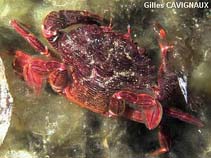Liocarcinus corrugatus (Pennant, 1777)
Wrinkled swimcrabWarning: DOMDocument::load(): SSL operation failed with code 1. OpenSSL Error messages: error:140770FC:SSL routines:SSL23_GET_SERVER_HELLO:unknown protocol in C:\Apache24\htdocs\includes\SpeciesSummary.lib.php on line 1236
Warning: DOMDocument::load(): Failed to enable crypto in C:\Apache24\htdocs\includes\SpeciesSummary.lib.php on line 1236
Warning: DOMDocument::load(https://sealifebase.nrm.se/webservice/AquaMaps/getAMap.php?genus=Liocarcinus&species=corrugatus): failed to open stream: operation failed in C:\Apache24\htdocs\includes\SpeciesSummary.lib.php on line 1236
Warning: DOMDocument::load(): I/O warning : failed to load external entity "https://sealifebase.nrm.se/webservice/AquaMaps/getAMap.php?genus=Liocarcinus&species=corrugatus" in C:\Apache24\htdocs\includes\SpeciesSummary.lib.php on line 1236
Classification / Names Common names | Synonyms | CoL | ITIS | WoRMS
Malacostraca | Decapoda | Polybiidae
Environment: milieu / climate zone / depth range / distribution range Ecology
Benthic; depth range 18 - 60 m (Ref. 435). Subtropical
Distribution Countries | FAO areas | Ecosystems | Occurrences | Introductions
Atlantic, Indo-Pacific and the Mediterranean: from Angola to the British Isles and the Mediterranean, and Japan to Australia and New Zealand (Ref. 435). Anti-tropical (Ref. 84890).
Length at first maturity / Size / Weight / Age
Maturity: Lm ? range ? - ? cm Max length : 5.0 cm CL male/unsexed; (Ref. 435); common length : 2.0 cm CL male/unsexed; (Ref. 435)
Maximum carapace width: 6.0 cm; common carapace width: 2.4 cm (Ref. 435). Minimum depth recorded is 18 m (Ref. 079266). Occurs from the littoral area to depths of 60 m, on coarse bottoms (Ref. 435).
Life cycle and mating behavior Maturity | Reproduction | Spawning | Eggs | Fecundity | Larvae
Members of the order Decapoda are mostly gonochoric. Mating behavior: Precopulatory courtship ritual is common (through olfactory and tactile cues); usually indirect sperm transfer.
Main reference
References | Coordinator | Collaborators
Fischer, W., G. Bianchi and W.B. Scott (eds.). 1981. (Ref. 435)
IUCN Red List Status (Ref. 130435)
CITES status (Ref. 108899)
Not Evaluated
CMS (Ref. 116361)
Not Evaluated
Threat to humans
Human uses
Fisheries: of no interest
| FishSource |
Tools
More information
Internet sources
BHL | BOLD Systems | CISTI | DiscoverLife | FAO(Publication : search) | Fishipedia | GenBank (genome, nucleotide) | GloBI | Gomexsi | Google Books | Google Scholar | Google | PubMed | Tree of Life | Wikipedia (Go, Search) | Zoological Record
Estimates based on models
Preferred temperature
(Ref. 115969): 9.9 - 27.6, mean 20.6 (based on 450 cells).
Price category
(Ref. 80766):
Unknown.



